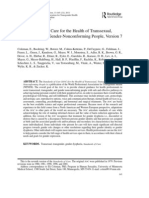TORCULAS
TORCULAS
Uploaded by
Hannah Carijutan TorculasCopyright:
Available Formats
TORCULAS
TORCULAS
Uploaded by
Hannah Carijutan TorculasOriginal Title
Copyright
Available Formats
Share this document
Did you find this document useful?
Is this content inappropriate?
Copyright:
Available Formats
TORCULAS
TORCULAS
Uploaded by
Hannah Carijutan TorculasCopyright:
Available Formats
TORCULAS, HANNAH CARIJUTAN
BSED VALUES 1A
UNDERSTANDING THE SELF
LESSON 2: Gender and Sexual Orientation
Gender
Gender is a term that used to describe the characteristics, whether biologically or
socially influenced, that people use to define males and females (Myres & Twenge,
2017). It is shaped by cultural expectations and social roles that affect people’s self-
concept, behaviors and aspirations (Rathus, 2014). We basically learn about our gender
and to act accordingly, that is based on our gender roles, through a lifelong socialization
process. Even before we’re born, a name as chosen for us usually based on our
gender. Then we grew up exposed to gender-specific activities and are encourage and
rewarded for what are considered as gender appropriate roles and behaviors. For
instance, women have always expected to perform housework and childcare, while men
are responsible for the household repair. Women dominate in teaching and nursing
while men, in the world of engineering and mining. Certainly, there have been changes
in the gender roles overtime but there are cultural expectations and gender stereotypes
that remain deeply ingrained in society.
The awareness of one’s gender identity usually starts with self-categorization
that influences individuals to engage in gender-typed behaviors (Keener, 2015). In
Bem’s (1981) gender schema theory, our identification as man or woman affects our
development, because it directs what we pay attention to and process. Gender is
traditionally understood based on binary categories; male/masculine and
female/feminine. Typically, girls and boys grow up to be more inclined to notice and to
engage in behaviors that are expected of their gender. However, there are people who
cannot identify with either of these binary categorizations and who find their interests
and inclinations to be also non-typical. The table below is the different terminologies
complied by Keener (2015).
Table 1: Gender Identity Terminologies
CISGENDER Is male or female that identifies with the
sex that was assigned at birth. Cisgender
people also identify, to some degree, with
the gender norms (excluding sexual
orientation) that are associated with their
sex.
GENDERQUEER Is used to describe a gender identify
when the binary conceptualization of
gender, male or female, does not
accurately describe an individual’s
gendered outlook our self-concept.
INTERSEX Describes a variety of medical conditions
wherein an individual’s reproductive
anatomy or genitals do not fit the binary
definition of male or female.
TRANSGENDERMAN/ FEMALE TO Is a man whose sex is female, but he
MAN (FtM) lives and identifies as male
TRANSGENDER WOMEN/ MALE TO Is a woman whose sex is male, but she
FEMALE (MtF) lives and identifies a female.
Gender expression or the manner by which people express themselves and
behave may be true to their gender identity such as when they convey their sense of
femininity or masculinity outwardly. This may occur naturally for the majority, that their
actions are effortless. However, there are some people whose gender expression does
not match their gender identity and who are more comfortable dressing up and
presenting themselves as an opposite sex. We are familiar with cases where a woman
is comfortable presenting herself in masculine ways such as wearing a man’s clothing,
or a man is acting in feminine ways such as being fussy with house decors. However,
there are those who undergo transexual surgery but who still keep their original gender
identity and even their sexual orientation. Celebrities like Caitlyn Jenner and Angie King
are biologically male but became transwomen and they remained to be heterosexual in
sexual orientation.
Sexual Orientation
Sexual orientation refers to the stable pattern of attraction or sexual interest that
one has to a member of a particular sex. It can also mean the complete absence of any
sexual interests. Sexual orientation should not be mistaken as sexual behavior because
they are not necessarily the same. For instance, there are some people who engage in
same-sex behavior and fantasy but maintain a strong heterosexual orientation (Freberg,
2010).
Majority of the people have heterosexual orientation, that is their sexual interest
is towards people of the opposite sex. Others have homosexual orientation in which
their sexual and romantic interests are with same sex individuals and they are either
gay or lesbian. There are others whose orientations do not fall from the aforementioned
categories. Table 2 is the list of the different sexual orientation of people (Keener,
2015).
Table 2: Sexual Orientation Terminologies
ASEXUAL Refers to the absence of physical or
sexual attraction to another human being.
An asexual man or woman can have
romantic, intellectual or emotional
attractions to other people, but they do
not engage physical sexual acts.
BISEXUAL The sexual orientation that describes
either male or female who is attracted to
both males and females.
GAY Depending on the context, gay can refer
to either gay males and/or lesbians. Gay
males are self-identification men who are
emotionally, physically, romantically
and/or sexually attracted to people who
identify.
LESBIAN A self-identified female who is
emotionally, physically, romantically
and/or sexually attracted to other people
who identify as female.
HETEROSEXUAL An individual who identifies as either a
male or female (can be cisgender, FtM, or
MtF) and is attracted to individuals of
opposite sex.
QUEER Is an umbrella term that is used to
describe an individual’s self-concept of
their sexual orientation identity.
Gender is often understood as a binary concept, with male and female being the
two traditional categories. However, it is important to note that gender is not solely
limited to these binary options. Some individuals as non-binary, genderqueer, or
genderfluid, and may not identify with strictly male or female gender roles. Gender
encompasses a variety of aspects including gender identity, which refers to an
individual’s internal sense and experience of their own gender, whether it aligns with
their assigned sex or not. It also includes gender expression, which refers to the way
individuals outwardly communicate their gender through appearance, behavior, clothing,
and other means.
Gender is a complex and multifaceted concept that intersects with other aspects
of an individuals identity, such as race, ethnicity, sexuality, and class. It can shape
peoples experiences, opportunities, and expectations, and has significant implications
for social, economic, and political structures. The understanding and interpretation of
gender vary across cultures and societies, leading to ongoing discussions and debates
about gender equality justice.
Gender refers to the socially constructed roles, behaviors, activities, and
expectations that society deems appropriate for individuals based on their sex. While
sex refers to the biological differences between males and females, such as
reproductive organs and chromosomal composition, gender is cultural and social
concept that varies across different societies and time periods.
You might also like
- Final Exam Intro SociologyDocument13 pagesFinal Exam Intro Sociologynaya12345678991% (11)
- Good Answers Guide 2019Document101 pagesGood Answers Guide 2019kermitspewNo ratings yet
- 2019-05-01 Attitude Magazine PDFDocument164 pages2019-05-01 Attitude Magazine PDFJhamesjhoRonquillo100% (1)
- Gender and Sexual OrientationDocument12 pagesGender and Sexual OrientationGrace Ragos RetigNo ratings yet
- Gender-And-Sexual-Orientation (1) 2Document11 pagesGender-And-Sexual-Orientation (1) 2Desiree QuinajonNo ratings yet
- Sexual SelfDocument25 pagesSexual SelfMJ OcañaNo ratings yet
- A. Sex vs. Gender B. Sexual OrientationDocument22 pagesA. Sex vs. Gender B. Sexual Orientationkate buyuccanNo ratings yet
- El 2 Gender and Society Full ModulesDocument26 pagesEl 2 Gender and Society Full ModulesLindzy Lagundino LegardeNo ratings yet
- The Sexual SelfDocument53 pagesThe Sexual SelfMarco FloresNo ratings yet
- Unit 2: The Sexual SelfDocument8 pagesUnit 2: The Sexual SelfFour NinesNo ratings yet
- Gas Introduction-Chapt.1Document47 pagesGas Introduction-Chapt.1Rei ChanNo ratings yet
- Addendum - Grade 10 - LIFE ORIENTATION - 2023-2024Document12 pagesAddendum - Grade 10 - LIFE ORIENTATION - 2023-2024Lebogang MalumaneNo ratings yet
- Chapter-3.3 SOGIEDocument25 pagesChapter-3.3 SOGIEs.prosia.maviemhoniqueNo ratings yet
- FINAL BEED 1 SOCSCI 111 (Reporter 4)Document19 pagesFINAL BEED 1 SOCSCI 111 (Reporter 4)Queenie Najera Basan IntendenciaNo ratings yet
- Gender and SexDocument40 pagesGender and SexAnglica Rae MandantesNo ratings yet
- Sexual OrientationDocument17 pagesSexual OrientationSuraj SukhuNo ratings yet
- Ge11 Lesson 1 1Document4 pagesGe11 Lesson 1 1Katherine GarciaNo ratings yet
- Gender IdentityDocument18 pagesGender IdentityNonito Vale100% (1)
- Chapter 2Document17 pagesChapter 2perezmilkyabegailNo ratings yet
- Handouts Sexual Orientation 1Document4 pagesHandouts Sexual Orientation 1Ken FurioNo ratings yet
- Gee ReviewerDocument6 pagesGee ReviewerMikel NinalgaNo ratings yet
- LGBT+ Infographics by SlidesgoDocument17 pagesLGBT+ Infographics by SlidesgoSreelakshmi MsNo ratings yet
- Janvi J LGBTQ CounsellingDocument29 pagesJanvi J LGBTQ CounsellingjanviNo ratings yet
- Group 2 Sexualit YDocument16 pagesGroup 2 Sexualit YEM RiveralNo ratings yet
- Midterm Reviewer (GEC 1)Document5 pagesMidterm Reviewer (GEC 1)Janna Andrea GeneraloNo ratings yet
- GENDERDocument18 pagesGENDERbevienlynpepito10No ratings yet
- Gensoc ReviewerDocument5 pagesGensoc ReviewerMaffy PeridoNo ratings yet
- Gender and Society ReportDocument3 pagesGender and Society ReportYahle Chavee ApudNo ratings yet
- LGBTQ DefenitionsDocument3 pagesLGBTQ DefenitionsgellaialmanonNo ratings yet
- Lesson 4Document30 pagesLesson 4syntaxerror0089No ratings yet
- Cavite State University AY. 2020-2021: Sexual Orientation, Gender Identity, Expression, and Sex CharacteristicsDocument5 pagesCavite State University AY. 2020-2021: Sexual Orientation, Gender Identity, Expression, and Sex CharacteristicsBea Reen BurgosNo ratings yet
- Gender Lecture 1Document5 pagesGender Lecture 1Kian SalesNo ratings yet
- Addendum - Grade 10 - LIFE ORIENTATION - 2023-2024Document13 pagesAddendum - Grade 10 - LIFE ORIENTATION - 2023-2024nhlamulopretty30No ratings yet
- LESSON2 TASK2 GEELEC4 Santos, AllyanaMarie - ABPOLSCI2ADocument7 pagesLESSON2 TASK2 GEELEC4 Santos, AllyanaMarie - ABPOLSCI2AAllyanaMarieSantosNo ratings yet
- GenderDocument6 pagesGendergavin syNo ratings yet
- Gender and SocietyDocument11 pagesGender and SocietyJUDY ANN DE GUZMANNo ratings yet
- GNED 10 Lesson 2 GenderDocument18 pagesGNED 10 Lesson 2 GendermarasiganjazdaleNo ratings yet
- Sexual SelfDocument30 pagesSexual SelfKenneth Coralde RamisoNo ratings yet
- Sex Gender and SexualityDocument14 pagesSex Gender and SexualityEya BaldostamonNo ratings yet
- Sogie 101 2017Document20 pagesSogie 101 2017Julian ManongdoNo ratings yet
- Gender and Society Lesson 2Document12 pagesGender and Society Lesson 2Kate BiscarraNo ratings yet
- Gender & Society 3Document6 pagesGender & Society 3Mark Eugene DeocampoNo ratings yet
- MIDTERM REVIWER Understanding The SelfDocument5 pagesMIDTERM REVIWER Understanding The Selferanaandreafaye2No ratings yet
- SExual Orientation - 20231115 - 074504 - 0000Document9 pagesSExual Orientation - 20231115 - 074504 - 0000cleobiaresNo ratings yet
- PRELIM Learning KitDocument6 pagesPRELIM Learning KitRegina Joy JabonNo ratings yet
- Sexual SelfDocument13 pagesSexual SelfGahol King AieNo ratings yet
- Sex and GenderDocument28 pagesSex and GenderMark Porcadilla100% (1)
- Child Abuse Rape: Gender Identity and Sexual Orientation Are NotDocument82 pagesChild Abuse Rape: Gender Identity and Sexual Orientation Are NotRihanna HartNo ratings yet
- LGBT Allies WorkshopDocument12 pagesLGBT Allies WorkshopCatrionaNo ratings yet
- LGBT PsychologyDocument18 pagesLGBT Psychologyaxljakebarcancel5No ratings yet
- Gender and SEX: John Carlo C. LorbisDocument24 pagesGender and SEX: John Carlo C. LorbisJOHN CARLO LORBISNo ratings yet
- Gender and SocietyDocument3 pagesGender and SocietyRhod Cedrick RamosNo ratings yet
- Gender EducationDocument40 pagesGender EducationNivollNo ratings yet
- Group 8 - Topic 10 - The A-Z of Gender - Gen&socDocument4 pagesGroup 8 - Topic 10 - The A-Z of Gender - Gen&socBandibas Faith V.No ratings yet
- Gensoc ReviewerDocument1 pageGensoc ReviewerCharm Nicole A. PenullarNo ratings yet
- Lesson 5 Gender and SocietyDocument29 pagesLesson 5 Gender and SocietyjlawrencebaccayNo ratings yet
- GensocDocument5 pagesGensocespirituamie230No ratings yet
- Lesson+1 2 +Leveling+Off++Gender+and+SexualityDocument24 pagesLesson+1 2 +Leveling+Off++Gender+and+SexualityJe ArcenalNo ratings yet
- Human SexualityDocument22 pagesHuman SexualityAngeli VillarNo ratings yet
- Report Chapter 2 Lesson 2 Ngec 11Document18 pagesReport Chapter 2 Lesson 2 Ngec 11benjamin081006No ratings yet
- W4-Module 004 - The Social Construction of Gender RelationsDocument5 pagesW4-Module 004 - The Social Construction of Gender RelationsMr.CinnamonNo ratings yet
- Sexual SelfDocument65 pagesSexual SelfJein Graceilyn L. Cabangon100% (1)
- HIV AIDS Teacher Training Manual2Document156 pagesHIV AIDS Teacher Training Manual2Shellsia St JusteNo ratings yet
- Thesis Topics Social StudiesDocument5 pagesThesis Topics Social Studiesbetsweikd100% (2)
- Guide For Review of GPB and GAR PDFDocument56 pagesGuide For Review of GPB and GAR PDFcarlito alvarezNo ratings yet
- B.Ed - 2nd - Year - (Block - 1,2,3 & 4) - Pedagogy of EnglishDocument303 pagesB.Ed - 2nd - Year - (Block - 1,2,3 & 4) - Pedagogy of EnglishRudramuni HiremathNo ratings yet
- Module 1. Human VariationDocument27 pagesModule 1. Human VariationGonzales Juliefer AnnNo ratings yet
- Gec 110 - DiscussionDocument5 pagesGec 110 - DiscussionMa'am CharryNo ratings yet
- Regimes of Value in Mexican Household Financial Practices: by Magdalena VillarrealDocument10 pagesRegimes of Value in Mexican Household Financial Practices: by Magdalena VillarrealArturo EsCaNo ratings yet
- Why Governments Should Invest More To Educate Girls T. Paul SchultzDocument49 pagesWhy Governments Should Invest More To Educate Girls T. Paul SchultzAhmed FayekNo ratings yet
- Language, Gender and Reality': Violence Against Women: Patricia Easteal, Lorana Bartels, Sally BradfordDocument14 pagesLanguage, Gender and Reality': Violence Against Women: Patricia Easteal, Lorana Bartels, Sally BradfordleoNo ratings yet
- A Brief Report On The ROSE ProjectDocument3 pagesA Brief Report On The ROSE ProjectSamrat MukhopadhyayNo ratings yet
- CH 1 Psych of Gender NotesDocument6 pagesCH 1 Psych of Gender NotesmomoNo ratings yet
- Third Gender Roles Ethnographic ExamplesDocument5 pagesThird Gender Roles Ethnographic ExamplesMichael Alan CohenNo ratings yet
- English 105 AssignmentDocument6 pagesEnglish 105 AssignmentRitz hNo ratings yet
- Brainstorming For Essential Question: Lesson PlanDocument5 pagesBrainstorming For Essential Question: Lesson Planapi-267989126No ratings yet
- Lack of Education Research Paper 1Document9 pagesLack of Education Research Paper 1api-547809341No ratings yet
- The Family and Economic Development PDFDocument9 pagesThe Family and Economic Development PDFmineasaroeunNo ratings yet
- Nandini Bhattacharjee - Through The Looking GlassDocument20 pagesNandini Bhattacharjee - Through The Looking Glassकृतिश्रीवास्तवNo ratings yet
- POD - Unit 3 PDFDocument59 pagesPOD - Unit 3 PDFpriyankaNo ratings yet
- Ijerph 15 00329 PDFDocument13 pagesIjerph 15 00329 PDFmellysa iskandarNo ratings yet
- 29 1 S2020 SzekelyhidiDocument10 pages29 1 S2020 SzekelyhidiorangieNo ratings yet
- Feminism Criticism NptelDocument24 pagesFeminism Criticism NptelRafeeq HassanNo ratings yet
- Laetitia Essay 5Document1 pageLaetitia Essay 5eonstephen2008No ratings yet
- Feminism and Pop Culture Seal Studies - (Intro)Document5 pagesFeminism and Pop Culture Seal Studies - (Intro)Esha NaranNo ratings yet
- Course OutlineDocument11 pagesCourse OutlineSihle SondamaseNo ratings yet
- 'The Dark Side of Wartime Experience'? Calling Into Question Feminist Film Noir TheoryDocument9 pages'The Dark Side of Wartime Experience'? Calling Into Question Feminist Film Noir TheoryCristelle MaryNo ratings yet
- 2011 - SOC-7 - Standards of Care For The Health of Transsexual, Transgender, and Gender-Nonconforming People, Version 7Document68 pages2011 - SOC-7 - Standards of Care For The Health of Transsexual, Transgender, and Gender-Nonconforming People, Version 7Chrysallis Afmt100% (1)
























































































